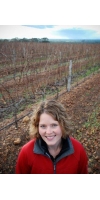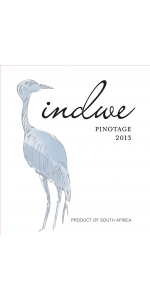Wine from Indwe

The Indwe Estate
At the southern-most tip of Africa, where the Atlantic and Indian Oceans meet, one finds the ‘Cape of Storms’, or more commonly, Cape Agulhas. On this peninsula lies the Elim ward and Overberg region, where we source the grapes for Indwe Sauvignon Blanc. Indwe is the Xhosa name for the Blue Crane, South Africa’s national bird. It is an endangered species and endemic to South Africa, particularly the Overberg region. The Blue Crane is very special to the amaXhosa and amaZulu, often associated with warriors and royalty.
Owner and Winemaker is Trizanne Barnard. During her productive vinous career, she has seized every possible opportunity to broaden her knowledge and experience, pressing them for every drop of goodness they offered, enriching her life, her work and her wine. With a B.Sc Agric under her belt she stepped into the real world of wine, completing harvests in Western Australia, Alsace, Bordeaux, Rhone and Douro Valley.
Back on home soil, after a year at Klein Constantia she was challenged with setting up a winery in the Helderberg. After four successful years,she decided it was time to venture on my own, creating her own project.
The Indwe Estate
At the southern-most tip of Africa, where the Atlantic and Indian Oceans meet, one finds the ‘Cape of Storms’, or more commonly, Cape Agulhas. On this peninsula lies the Elim ward and Overberg region, where we source the grapes for Indwe Sauvignon Blanc. Indwe is the Xhosa name for the Blue Crane, South Africa’s national bird. It is an endangered species and endemic to South Africa, particularly the Overberg region. The Blue Crane is very special to the amaXhosa and amaZulu, often associated with warriors and royalty.
Owner and Winemaker is Trizanne Barnard. During her productive vinous career, she has seized every possible opportunity to broaden her knowledge and experience, pressing them for every drop of goodness they offered, enriching her life, her work and her wine. With a B.Sc Agric under her belt she stepped into the real world of wine, completing harvests in Western Australia, Alsace, Bordeaux, Rhone and Douro Valley.
Back on home soil, after a year at Klein Constantia she was challenged with setting up a winery in the Helderberg. After four successful years,she decided it was time to venture on my own, creating her own project.
The Vineyards
The historic mission settlement of Elim on the Agulhas Plain comprises 6 500 hectares of land.  Half of this land is under agriculture and for the past one hundred years has been cultivated and the remaining + 3 000 hectares of Elim ferricrete fynbos is managed by the Moravian Church and the community at the Elim mission station.
Elim was established in 1824 by Moravian missionaries and sacramental wine was required for church services, and the first vineyard planting in this region subsequently occurred over 100 years ago however viticulture didn’t really establish until 1997 when it resumed again.
First Vineyard plantings: 1996 – Lands End. After Lands End, The Berrio planted the next vineyards in 1997.
Producers in Elim:
- The Berrio: 33.7 hectares (planted with 80% of white grape varietals)
- Black Oystercatcher: 18 hectares (planted with 68% of white grape varietals)
- First Sighting: 70 hectares (planted with 55% of white grape varietals)
- Zoetendal: 7.46 hectares (planted with 85% of white grape varietals)
Total hectares of vineyards 129.16 Ha = 319.161 Acres
White grape varietals found on Elim: approximately 80% Sauvignon Blanc, 15% Semillon and the rest is small parcels of Viognier, Nouvelle.
Indwe Pinotage Coastal Region is made from 100 percent Pinotage.
Pinotage is a true South African grape variety, Our signature grape smilar to the Blue Crane being our national bird. Indwe Pinotage grapes are meticulously sourced from our grape producers along the Coastal region of the Western Cape ensuring complexity, depth and purity of fruit. The wine is layered with sweet cherry notes, and subtle hints of mocha and vanilla flavors.
- back
Selected Options
Wineries
Categories
Pricing
Countries
Regions
Grape Types
Wineries
Organic/Free Shipping
All older vintage wines have been purchased from a single collectors cellar. Pictures can be requested before shipment.
Spinona Bricco Faset Barbaresco is made from 100 percent Nebbiolo.
This single-vineyard Barbaresco comes from Pietro Berutti's 8 hectares of coveted vineyards on the top of the historic hill, Faset. It is 270 meters above sea level with a south, south-east exposure. The vines are an average of 35 years old. Only organic farming practices are used. The natural fertilizer comes from the 100 head of cattle that they have and no herbicides or pesticides are used.
Barbaresco shows a deep ruby red color with garnet reflections. An intense bouquet with hints of ripe cherries, wild berries and spice. White pepper, licorice and mint blend with enticing floral notes. Mouth-filling and well-structured with a full, velvety body and an austere and long finish.
HARVEST: late October. The grapes are harvested by hand in perforated baskets to allow air to pass through the bunches. The pressing is soft. Cold maceration for 24 hours at 12°C (for certain years).
WINEMAKING: Soft pressing with an initial cold maceration on the skins for 24 hours at 12C. Specially selected yeasts are used. Fermentation takes place for 12 to 14 days in stainless steel at 28-29 °C under temperature controlled conditions. There is a pumping over on the skins. After malolactic fermentation, the wine is racked and goes through a delicate pressing to obtain only the best wine.
AGING : 12-15 months in large 25 hectolitre wooden barrels of Allier and Slavonian oak.
REFINING: in the bottle for 12-15 months in a temperature-controlled environment.
Excellent with game, red meats, truffle dishes and aged cheeses.
This single-vineyard Barbaresco comes from Pietro Berutti's 8 hectares of coveted vineyards on the top of the historic hill, Faset. It is 270 meters above sea level with a south, south-east exposure. The vines are an average of 35 years old. Only organic farming practices are used. The natural fertilizer comes from the 100 head of cattle that they have and no herbicides or pesticides are used.
Barbaresco shows a deep ruby red color with garnet reflections. An intense bouquet with hints of ripe cherries, wild berries and spice. White pepper, licorice and mint blend with enticing floral notes. Mouth-filling and well-structured with a full, velvety body and an austere and long finish.
Review:





